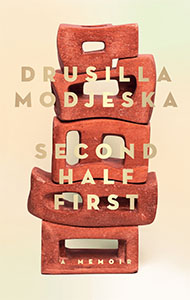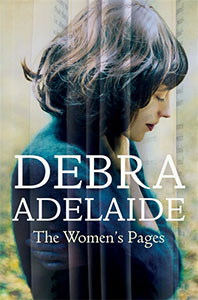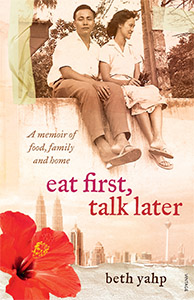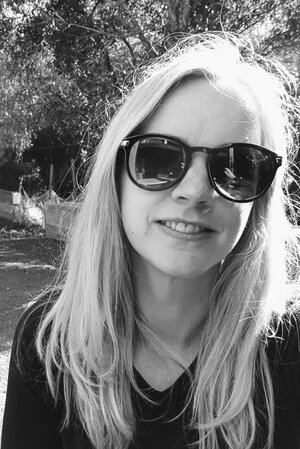These three new titles – two memoirs and a novel – each written by a well-established local author of fiction, are concerned with what it might mean to map the contours of a life on the page. Where to begin and where to end; what to include or to leave out. What particular significance might self-transcription have for women writers as they seek to trace continuities and discontinuities in female experience from their own lives to their mothers’ or grandmothers’ generations?
For Drusilla Modjeska, the sweep of Second Half First is not that of an autobiography or perhaps even a memoir but ‘simply a reflection on the arc of life’. Neither is Beth Yahp’s stylistically heterogeneous and thoroughly researched Eat First, Talk Later typical of the memoir form, charting the author’s circuitous quest to recover her parents’ personal histories by taking them back to Malaysia for a road trip down memory lane. Debra Adelaide’s intriguing and emotionally rich narrative puzzle in The Women’s Pages offers us a fiction within a fiction, interweaving the lives of two women – one of whom, it seems, is the creation of the other.
How blurred is the line between fiction and memoir, given the pliability of memory, its lacunae and its distorted focus? If we decide to illuminate particular moments in our past, do we thereby create a fiction of their prominence? Such moments can be revised, revisited, remade – scenes in Eat First, Talk Later are reshaped as they are seen from new angles; reflections in Second Half First twisted to catch a new light. And for writers of fiction, what does it mean to feel the emotions of one’s characters as if they were one’s own, as Dove, the protagonist-cum-author of The Women’s Pages, does? What does it mean to decide the fates of these characters, who have become like companions?
Second Half First, as its name suggests, does not begin at the beginning. Or perhaps it is more accurate to say that it begins at one of many beginnings, which is also and most obviously an ending. On the night before the author’s fortieth birthday a romantic relationship reaches its dissolution, having begun in the aftermath of another ending – the premature death of Modjeska’s mother, Poppy, 17,000 kilometres away in London. The breakdown of this relationship opens the memoir and unspools its early threads, marking – along with Poppy’s death – a kind of tide mark in Modjeska’s life, to which she will return in writing thirty years later. It is a catalyst for, rather than a focal point of, what turns out to be a wide-ranging, digressive, loosely structured, thoughtful and thought-provoking memoir (of sorts). Modjeska traverses a breadth of personal territory, sketching patterns of alignment and fragmentation, alighting here and there on moments of connection, separation, grief or revelation.
Some 25 years after the publication of her fictionalised and eponymous biography of Poppy, Modjeska again contemplates the myriad and often intangible ways in which we are formed by our parents’ histories, and considers how very long it can take us to understand the extent of their influence; how long, sometimes, before we even seek our parents’ stories out. She returns in memory to her mother and her father, having done so physically in the days and weeks preceding each of their deaths. It is a process which continues for many years after they are both gone. Perhaps not surprisingly, given Modjeska’s longstanding interest in personal histories, it is the spectre of memory which concerns her; not simply that store of sensations, experiences or impressions built up over the course of a life, but also the idea of memory, its function, form and fabric.
Modjeska’s is a discursive and engaging voice, her contemplation of this ‘second half’ of a life unapologetically candid. The prose is exploratory and flexuous; she revises and revisits words, phrases or images, occasionally switching tense within the span of a page or even a paragraph. As she observes of her craft,
words bend and weave, sentences and paragraphs gathering in stories, digressing and doubling back, making a pattern that may not be able to be apprehended as an embodied work to walk around, but can reveal its shape in the mind of a reader, a compatriot, a stranger.
Much of Second Half First dwells on the relationship of writers – novelists, biographers, memoirists – to one another, and their imaginative lives as readers. This history of Modjeska’s life is at least partly the history of her reading, and some of the most engaging sections of the book are those in which she traces the currents of her reading practice through periods of intellectual exploration or emotional succour. An early mentor, the critic and poet Dorothy Auchterlonie Green, propels this mining of literature for life.
Go back, she said. Go back to the mothers, to the world yours was born into and that you came from.
In returning to her literary mothers, Modjeska uncovers lives shaped by the tug of war between ‘love and independence of mind’: Simone de Beauvoir, Christina Stead, Rebecca West, Doris Lessing and Anna Wulf, the latter’s protagonist in The Golden Notebook. Can we, as Modjeska implores West’s biographer Victoria Glendinning (whose pointed exposure of the contradictions in West’s attitude to marriage she loathes), not honour rather than deplore the inconsistencies in women’s lives, the ructions caused by the tension between independence and love?
Rather than catching a woman out, couldn’t there be a way of writing her life that honoured – rather than excused – the inconsistencies, the confusions, that – as I knew from my own wavering, criss-crossing desires – were still integral to the struggle to live with both love and independence of mind in a world that did not easily accord this combination to a woman?
Second Half First is a meditation on these inconsistencies and on the struggle to accommodate both independence and love in Modjeska’s life and in the lives of other women writers and artists. She asks us to embrace contradiction, and to allow ourselves and others ‘wavering, criss-crossing desires’.
Ambivalence, uncertainty; the experience of life between the lines of the tide: that was the story, not the certainty of bricks.
The form of Second Half First is in its own way a celebration of ambiguity, contradiction and inconsistency. Modjeska moves back and forth across decades and continents – from her much loved ‘house on the corner’ in Enmore to the mountainous villages of the Ömie tribe in Papua New Guinea, and back to the New South Wales South Coast – blending stream-of-consciousness with passionate argument and astute self-reflection, as it slips throughout between a kind of extended essay and memoir.
Despite its status as a novel – and its structural incorporation of a fiction within another fiction – Debra Adelaide’s The Women’s Pages asks many of the same questions as Modjeska’s loose-limbed ‘reflection on the arc of a life’ in Second Half First; and indeed, shares others with Beth Yahp’s frustrated pursuit of her family history in Eat First, Talk Later. The façade of a conventional, close third-persona narrative – a young woman named Ellis, not long married and a new mother, attends a backyard barbeque in honour of the wedding anniversary of her husband’s friends – lasts only as long as the novel’s opening chapter. Soon enough, and before we are comfortably acquainted with our protagonist, her status as the fictional creation of another woman becomes apparent.
Ellis is revealed to be a character conjured by Dove, a creatively unsatisfied graphic designer who finds herself drawn back into the world of Wuthering Heights as she reads it to her adoptive mother, who is dying in hospital. Her creation is, of course, named for Emily Brontë, who wrote under the pen name Ellis Bell (and fans of Brontë will no doubt derive a certain gratification from this protagonist’s aptly named parents, Catherine and Edgar). The creative impulse as experienced by Dove is precisely that – an impulse, an urge, an itch. She finds herself accosted by an almost uncanny compulsion to write the story of Ellis, a young woman who feels unsuited to a life of matrimony and motherhood. Dove has never experienced either herself, and seems unlikely, if not uninclined, to do so in the future. That she ‘invented’ a child for Ellis because she – Dove – ‘needed him’ reveals how close the ties are between author and character; how strong the potential for a kind of emotional projection. Ellis appears to Dove full-fleshed, plaguing her author’s dreams and demanding realisation in prose. The novel has a doubled structure, as sections of Ellis’s story are intercut with that of her author – and indeed with the story of her own creation. In this sense it is an unashamedly literary novel, explicitly concerned with the writing process, and the entanglement of a novelist’s life with that of her protagonist. Here again we see the echoes of Lessing’s The Golden Notebook in the spectre of a protagonist who also an author, and a narrative frame which turns finally in upon itself.
Emerging over several interspersed chapters, Ellis takes on a life of her own – enigmatic and multilayered, selfish yet entirely sympathetic. Dove returns to details of the scenes she has conjured, building up the pieces of a day, an hour or a moment; sometimes even realising with a shock that she has got the scene ‘wrong’ – that in fact, Ellis would not have done this, gone there, said that. Dove is allowed her inconsistencies and contradictions – just as Modjeska would have the many women authors she admires forgiven theirs. Moving now back to adolescence, now forward to divorce and self-sufficiency, Ellis’s life accumulates its layers like a painting, until the creation has near eclipsed her creator.
As readers we come to know Ellis both independent of her author and through the process of her composition – an interplay which Adelaide handles with consummate skill. And in this most explicitly fictional of fictions arise some of those same questions begged by the memoirist. There are so many ways to write a life, where does one even start? What warrants our attention – where do we train our eye, our camera, our pen? Moreover, from what angle do we see? And what happens when we take a second glance, when we revise our first impression, or look from a different angle? Moments in Ellis’s life are first seen, then recast, sometimes even overturned, as Dove shifts her angle, a scene pressing itself anew upon her, unbidden and shaken up. Visiting the suburban Sydney street where she has imagined her characters into being,
Dove placed her hand on the picket gate then removed it. Something was wrong. She could see the scene that had replayed in her mind a thousand times, the scene so vivd where her story had first begun. It was as if it had happened just this morning, but there was a piece missing.
Just as Dove revisits the scenes she herself has written, trying to understand her own creation, Ellis will seek the stories of those who have shaped her, reappraise the scenes of her childhood, probe the absences by which it was defined. Like Modjeska – and Yahp – Ellis and Dove both seek their mothers, writing themselves into being through the process.
She had not meant to write the story of women but that was how it had appeared, that was the only story in her head. The more she delved into the lives of her characters the more it was about missing or silent women and the more it seemed it was her job to find them and open their mouths and pull their words out and lay them across the pages.
For the story of women is of course also the story of historical circumstance, the confluence of political, economic and social change. Ellis’s life, the lives of Dorothy Auchterlonie Green’s ‘mothers’ or those literary forebears whose struggle for ‘love and independence of mind’ so concerns Modjeska, are shaped by the availability of contraception and abortion, by access to education, by the opportunity to enter the workplace and thrive there unhindered by gendered discrimination, with equal remuneration to their male colleagues (we live in hope).
The Women’s Pages is a technically accomplished novel, weaving together its separate threads to a conclusion in which the division between them begins to break down. It is also a sheer pleasure to read – its prose elegant and polished, rich with telling detail, and moving without being sentimental. At its heart it is a fiction of fiction-making, celebrating the entanglement of authors with their characters, and conjuring the uncanny sense that these characters exist even beyond the imaginations of their creators.
At first glance Beth Yahp’s richly layered memoir of her own and her parents’ lives in Malaysia – between which and Sydney she continues to travel – may not seem to have a great deal in common with Adelaide’s meta-fictional novel or Modjeska’s meditative and meandering reflections; though the latter shares with Yahp her experiences as an expatriate, moving between two cultures and two different ideas of home. Yet here too arise those same questions: whose story am I writing – my own or that of my parents? From which angle? And why? To which Yahp answers,
It’s no defence, but this is my side. This side of the story is mine.
Eat First, Talk Later is a story steeped in Malaysian culture, politics, language and cuisine. Yahp conjures up the flavours and smells of delicious dishes of every colour and consistency, the paradisiacal image of beach-lapped islands, the clamour and sound of Kuala Lumpur and the consonant-filled rhythms of Malay. The writing is dense, lyrical, even occasionally opaque, moving back and forth between scenes from five, ten, fifty or seventy years ago sometimes within the space of a page – and between history, memory and self-reflection. Yahp’s warm and incisive humour inflects her prose as she fills the pages with the rhythms of several tongues.
Eat First, Talk Later is a memoir of travel and self-imposed exile of movement across continents and within relationships, between cultures and ideas of home, asking what it might mean to settle in Sydney, in Kuala Lumpur, or in Paris. Need we choose the place we call home? What might a peripatetic life in which home is not a city, a house or an apartment, look like? Yahp is formed by each of the places in which she has made at least a temporary home, as she is formed by her parents’ stories, and by the myriad cultures, languages, cuisines, traditions and identities of the country into which she was born. It is a country whose complicated history might be told – as it is, playfully, throughout by Yahp – via its rich culinary offerings: a history of foods.
The layering of political and historical detail throughout will be fascinating and informative for those readers (like me) who know relatively little of twentieth-century Malaysian history. Yahp’s involvement in political activism and her proximity to key opposition figures gives her a unique vantage point from which to explore her country’s recent history and the undercurrents of its political upheavals. She explores the intersection of this history with the lives of Malaysian citizens of all backgrounds, and with the stories of her own parents – their families, their first encounter, their courtship and their establishment of a life together.
There are many reasons why Yahp is interested in revisiting or uncovering the sites and scenes of Peter and Mara’s shared history. She is writing to bring their stories into the world as they reach old age; writing to make their stories hers as well; writing to understand. And as she does so she is interrogating what it might mean to seek such stories. Is the act of retelling them also an act of obscuring, an act of fictionalising?
Of course, I get it wrong. I’ve got whole chunks of the story wrong – places, people, periods. names, the sequence of events, never mind details of colour, shapes, sounds and smells, where it’s said truth resides; not in the cool, dry facts of things, but in their detail, the inflection in the way a child’s name is said – ‘Payao’ or ‘Creee-cher’ – a clipped voice sounding out from the doorway of an echoey room. I have my own memory of this. Shall I give it to Mara?
Where do these reminiscences sit between truth and fiction? What is the effect of these acts of misremembering, of revision, on Yahp’s quest to unravel and illuminate her parents’ lives – and what particular significance do such revisions have when they arise in memoir, as opposed to a fiction like Adelaide’s? This is, after all, Yahp’s side of the story.
In blending the stories of her family with the story of Malaysia, Yahp does not shy away from thorny questions of political and national identity, of responsibility for the actions of one’s leaders and for the place of one’s country in the world. The actions of Australia towards refugees and the role of Australians in endorsing or repudiating those actions sit alongside the tumultuous political history of Malaysia, the tensions simmering along ethnic lines and the ongoing repression of dissent. Which parts of a national identity do we choose to endorse, to identify with, and which to discard? Do we get to choose? Yahp finds herself goading her partner in Sydney with the spectre of Australian racism, identifying herself in those moments as outside the scope of collective responsibility for its manifestations. Perhaps, she muses,
I can’t see anything in ways uncoloured by race – whether I’m in Kuala Lumpur, or Paris, or Sydney.
While Yahp, Modjeska and Adelaide share the subject of women’s lives, only Yahp explicitly addresses the ways in which the lens of race shapes not only her experience but also her storytelling.
There is a difference in style between those passages of Eat First, Talk Later which focus on Malaysia’s history and the patterns of its political upheavals over some seventy years, and those sections in which Yahp allows her own personal reflections to unfold. The latter weave together fragments of information, scenes sometimes unanchored in time, a proliferation of images and conversations, rich with unanswered questions. At times this fluidity can obscure the course of events, making their temporal relationship to one another momentarily difficult to follow. I suspect however that this is deliberate, enhancing that sense of frustration and of incompleteness which pervades Yahp’s attempts to reconstruct histories that may never be known, that can never be uncovered to her satisfaction. She can’t make her parents tell their story the way she wants to hear it, because that story is not theirs.
Two memoirs, one fiction? Or one family history, two fictions entwined into a single narrative, and a ‘reflection on the arc of a life’? All three of these books show women writing themselves into being, as they construct narrative from the raw materials of unwieldy lives, whether imagined or real. Each writes and rewrites sensation, tactile detail, exchange or confrontation, revising and rediscovering through the process. The compulsion to self-transcription is persistent, whether it be in the service of self-discovery, exploration or interrogation; whether it comprises reflection, hindsight, or the recovery of stories which might otherwise be lost; whether it functions to challenge or to reinforce, as transformation or as testament – or simply as record.







